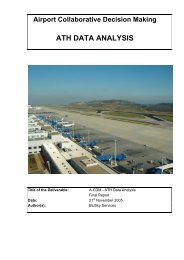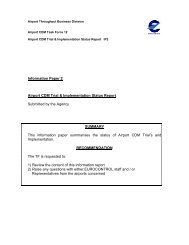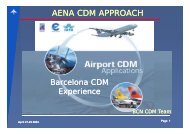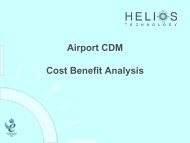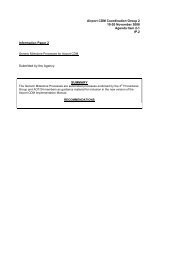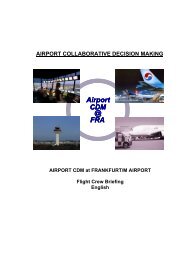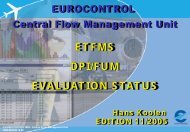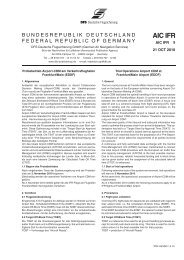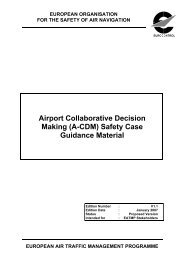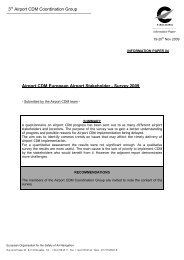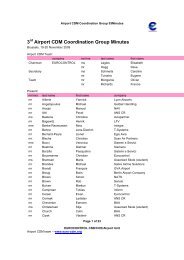DMAN / ASMGCS and Airport CDM Integration Concept
DMAN / ASMGCS and Airport CDM Integration Concept
DMAN / ASMGCS and Airport CDM Integration Concept
You also want an ePaper? Increase the reach of your titles
YUMPU automatically turns print PDFs into web optimized ePapers that Google loves.
<strong>DMAN</strong> integration in<br />
<strong>Airport</strong> <strong>CDM</strong> & A-SMGCS<br />
Klaus Haschke, Eugène Tuinstra<br />
20 November 2008<br />
EUROCONTROL Head Quarters<br />
<strong>Airport</strong> Operations & Environment Division<br />
EATM / DAP / AOE
Content<br />
1. <strong>DMAN</strong> Workshops 2008<br />
2. Integrated <strong>Concept</strong> with <strong>Airport</strong> <strong>CDM</strong> & A-SMGCS<br />
a) <strong>DMAN</strong> Definition, Benefits <strong>and</strong> Scope<br />
b) Operational <strong>Concept</strong><br />
3. Validation activities<br />
4. Topics & Future Workshops<br />
5. Questions
Past Activities<br />
Visits of <strong>Airport</strong>s Autumn 2007<br />
with <strong>DMAN</strong> experience<br />
Roadmap Dec 2007
<strong>DMAN</strong> Workshops 2008<br />
1 st Stakeholder Workshop 22 nd Feb 2008<br />
Attendance: 23 participants from 4 ANSP’s, 2 airports <strong>and</strong> 4 agencies/<br />
institutions<br />
Meeting the Industry March 2008<br />
at ATC Global 2008 in Amsterdam<br />
2 nd Stakeholder Workshop 12 th /13 th Jun 2008<br />
Attendance: 39 participants from 6 ANSP’s, 2 airports, 3 agencies, pilots <strong>and</strong><br />
industry with 7 companies
Objectives<br />
Objectives of Workshops:<br />
oSolutions for Variable Taxi Times (VTT)<br />
oTo find possible mitigations for sequence changes<br />
oRecovery from adverse conditions<br />
(i.e. insight in de-icing procedures)<br />
Discussions:<br />
VTT tables<br />
A-SMGCS surveillance data<br />
Passing Bays<br />
De-icing<br />
Electronic Flight Progress strips (EFPS)<br />
Routing <strong>and</strong> Guidance functions
What a <strong>DMAN</strong> does<br />
Effects<br />
Without … With …<br />
SAS637<br />
FIN654<br />
JAT131<br />
SNB223 12:21<br />
BLF413<br />
EXC031<br />
BLF417<br />
KLM1107<br />
SAS555<br />
SAS589 12:30<br />
Smooth & Predictable Traffic Flows<br />
FIN654<br />
JAT131<br />
SNB223 12:21<br />
BLF417<br />
Reduced Queues at RWY holding points<br />
Reduced Fuel burn, emissions <strong>and</strong> noise
From Manager to Management<br />
<strong>DMAN</strong> + <strong>Integration</strong> = Departure Management
Why an Integrated <strong>Concept</strong>?<br />
• To achieve benefits<br />
• SESAR dem<strong>and</strong>s<br />
• Synergy of Implementation <strong>Concept</strong>s<br />
• Runway throughput enhancement<br />
• Pre-Requisite for:<br />
– Mixed Mode Runway operations<br />
– TMA or ACC planning (departure metering)<br />
– European Network Planning<br />
– Global St<strong>and</strong>ardization & Harmonization<br />
Future advanced concepts require a<br />
robust basis on Surface Management!!
Generic Operational <strong>Concept</strong><br />
<strong>DMAN</strong> Definition<br />
<strong>DMAN</strong> is a planning system to improve departure<br />
flows at an airport by calculating the Target Take<br />
Off Time (TTOT) <strong>and</strong> Target Start-up Approval<br />
Time (TSAT) for each flight, taking multiple<br />
constraints <strong>and</strong> preferences into account.<br />
By<br />
Integrating into the <strong>Airport</strong> <strong>CDM</strong> concept<br />
for flight progress monitoring<br />
And<br />
<strong>Integration</strong> into A-SMGCS for surface<br />
traffic situation Monitoring
Who are the affected Partners?<br />
General Aviation<br />
<strong>Airport</strong> Operator<br />
Other services<br />
(Police, Customs etc)<br />
When we talk about <strong>Airport</strong> <strong>CDM</strong><br />
Partners, who do we mean?<br />
ATC<br />
AIS MET<br />
CFMU<br />
Aircraft Operators<br />
Ground H<strong>and</strong>lers
Benefits<br />
• Increased Operational Efficiency<br />
– Improve predictability of in & off-block times (AO & GH)<br />
– Reduced Taxi Times (Airlines)<br />
– Reduced Fuel consumption (Airlines)<br />
– Stabilized traffic flows (ATC)<br />
• Increased Safety<br />
– Less Workload (ATC)<br />
– Less stress <strong>and</strong> hectic situations (GH, Airline)<br />
• Enhanced ATM network<br />
– Increased number of utilized slots (CFMU, ATC)<br />
– Reduced number of assigned slots (CFMU, Airline)<br />
• Environment<br />
– Reduced Fuel emission (global warming)<br />
– Reduced Noise (residents around airport)
Scope<br />
• Ground Movements<br />
– Runways, Taxiways, Apron<br />
– No l<strong>and</strong>side planning or Total <strong>Airport</strong> Management<br />
• No Arrival management coupling<br />
• No TMA planning<br />
Applicable Timeframe<br />
• SESAR IP1<br />
– <strong>DMAN</strong> integration<br />
– <strong>Airport</strong> <strong>CDM</strong> & A-SMGCS level 1 (surveillance)<br />
• SESAR IP2<br />
– Enhanced support during taxi on surface<br />
– A-SMGCS levels 2+ (Guidance, Navigation)
Objectives<br />
1. Enhance Reliability of concepts & enablers<br />
• Demonstrate feasibility of technical Enablers by<br />
Validation<br />
• Establish acceptability of runway sequencing by<br />
controllers<br />
2. Increase achievability of Expected benefits<br />
• Enhance accuracy of off-block <strong>and</strong> take-off planning<br />
• Enhance robustness of sequence planning against<br />
disturbances or adverse conditions
Generic Operational <strong>Concept</strong> Applicability
Operational <strong>Concept</strong>: Phases<br />
Pre-tactical Phase Tactical Phase<br />
ALDT AIBT AOBT ATOT<br />
Inbound Taxi-in Turn-round<br />
Taxi-out Airborne<br />
Planning Execute<br />
Correct<br />
Measure
Operational <strong>Concept</strong>: Timelines<br />
Planning &<br />
Execution<br />
Pre-tactical Phase Tactical Phase<br />
Planning &<br />
Execution<br />
Planning Execution<br />
ALDT AIBT AOBT ATOT<br />
Inbound Taxi-in Turn-round Taxi-out<br />
Airborne<br />
Surveillance<br />
<strong>Airport</strong> <strong>CDM</strong> (IP1)<br />
Pre-departure Sequencing<br />
A-SMGCS (IP1)<br />
Surveillance<br />
Execution
Operational <strong>Concept</strong>: Sequence phases<br />
Planning &<br />
Execution<br />
<strong>Airport</strong> <strong>CDM</strong><br />
Pre-departure Sequencing<br />
Planning Execution<br />
ALDT AIBT AOBT ATOT<br />
Initial Sequence<br />
Pre-tactical Phase Tactical Phase<br />
Planning &<br />
Execution<br />
Optimise Stabilise<br />
Freeze<br />
T-DPI-c T-DPI-c T-DPI-s A-DPI FUM<br />
Inform CFMU on Milestone events<br />
Via Departure Planning Information (DPI) Messages<br />
Execution
Operational <strong>Concept</strong>: Integrated <strong>DMAN</strong><br />
Planning &<br />
Execution<br />
<strong>Airport</strong> <strong>CDM</strong><br />
Pre-departure Sequencing<br />
Planning Execution<br />
ALDT AIBT AOBT ATOT<br />
Initial Sequence<br />
Integrated <strong>DMAN</strong><br />
Pre-tactical Phase Tactical Phase<br />
Planning &<br />
Execution<br />
Control & Guidance IP2<br />
Surveillance<br />
Routing & Planning IP2<br />
A-SMGCS<br />
Optimise Stabilise<br />
Deviations<br />
Control & Guidance IP2<br />
Fixed<br />
Surveillance<br />
Correct Measure<br />
Execution
Lessons Learned<br />
Controller Use<br />
Preferred ATC Display<br />
Electronic Flight<br />
Progress Strips (GDN,<br />
RWY ATCO)<br />
Preferred Surface<br />
Display with Integrated<br />
Routing (ITWP project<br />
EEC)<br />
Timeline (Supervisor)<br />
Key Principles to Sequencing <strong>Concept</strong>s <strong>and</strong> Enablers<br />
Sequencing shall be flexible <strong>and</strong> adapt to actual<br />
events<br />
Planning shall support <strong>and</strong> not dictate the<br />
controllers in their work
Future <strong>Concept</strong> Development<br />
• A-SMGCS Route planning Guidance &<br />
Navigation<br />
– Cockpit support for navigation (EFB)<br />
• AMAN-<strong>DMAN</strong> coupling for mixed mode runway<br />
• Departure Metering for multiple airports in<br />
proximity
Need for Validation<br />
Problems Raised but discussion still ongoing:<br />
• VTT,<br />
• Sequence changes,<br />
• Recovery from adverse conditions etc.<br />
Hence:<br />
• Need for Validation<br />
• Implementation of <strong>DMAN</strong> in Live Operations<br />
• <strong>Integration</strong> with A-SMGCS within <strong>Airport</strong> <strong>CDM</strong>
Planned Validation<br />
ConOps Document<br />
A “Generic Operational <strong>Concept</strong> for <strong>DMAN</strong><br />
integration in <strong>Airport</strong> <strong>CDM</strong> <strong>and</strong> A-SMGCS”<br />
has been drafted.<br />
Call for Tender<br />
Validation of <strong>DMAN</strong> integration<br />
• Currently in preparation<br />
• Depending on available budget
Objectives & Future Workshops<br />
<strong>DMAN</strong> Validation for IP1 should assess:<br />
– Impact in taxi time reduction<br />
– Impact on controller workload<br />
– Impact on reduced emissions <strong>and</strong> noise abatement<br />
– Benefit of using surveillance data from A-SMGCS<br />
Surveillance<br />
– Adverse conditions operational procedures in <strong>Airport</strong><br />
<strong>CDM</strong><br />
Future workshops shall serve to assess<br />
stakeholder acceptance of concept.
Related<br />
Documents<br />
• <strong>Airport</strong> <strong>CDM</strong> Implementation Manual<br />
• A-SMGCS Level 1 & 2 Operational Requirements<br />
• SESAR Documents D3 <strong>and</strong> D6
T<br />
Thank you !



